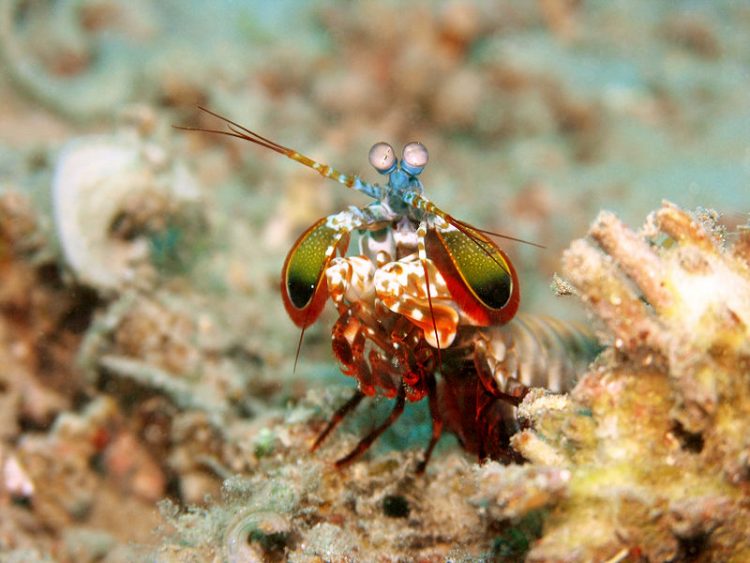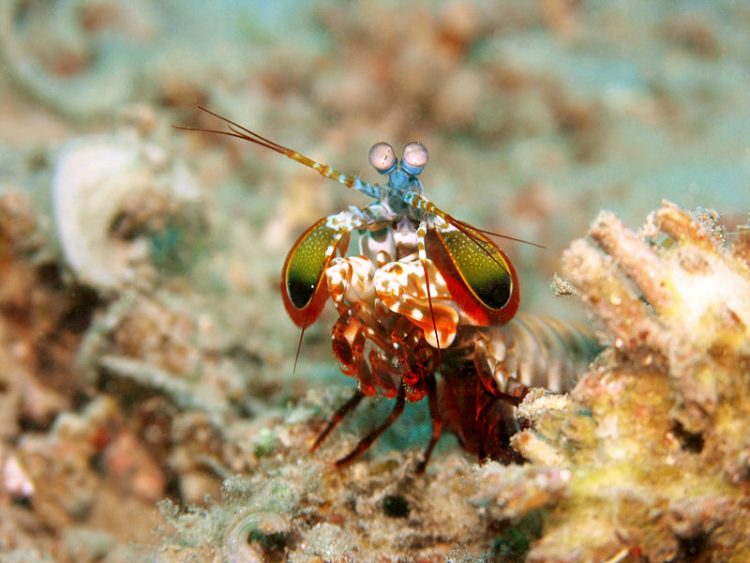The peacock mantis shrimp (Odontodactylus scyllarus) is recognized as having the fastest punch in the entire animal kingdom, with an acceleration comparable to a .22mm bullet fired out of a handgun.
One of several known mantis shrimp species, the O. Scyllarus is native to the seabed of the Indo-Pacific, from Guam to South Africa. It is an agile and active predator, using its club-shaped appendages to smash its prey, which mainly consists of other crustaceans, gastropods, and bivalves. The peacock mantis shrimp is known as a ‘smasher’ for a reason, as it uses its appendages to repeatedly deliver blunt force to its victims until it breaks their exoskeletons in order to reach the soft tissue underneath. Every blow travels at a speed of over 50 miles per hour (80 km/h), the fastest recorded punch of any living animal.

Photo: Jens Petersen/Wikimedia Commons
Not only is this shrimp’s punch as fast as a .22mm bullet, but it’s extremely powerful as well. Every swing delivers over 1,500 Newtons (340 lbs) of force, more than 2,500 times its own weight. Although delivered over very short time periods, typically between 49µs and 66µs, the punches are strong enough to crack regular quarter-inch class.
Cases of peacock mantis shrimps smashing through fish tanks have been recorded in the past, and the Berkley University website warns that large specimens (over 13cm in length) can break or chip glass. Their colorful bodies make them very popular pets, but keep in mind that you should consider a thicker or tempered glass fish tank, just to be sure.
So how is a small shrimp able to deliver such a fast and powerful punch? Well, its two club-like appendages are folded away under its head and secured with a spring-like latch. When unsuspecting prey gets near enough, the mantis shrimp releases the latch, launching its club arms forward. It’s a blazingly fast motion that leaves the victim dazed.
“The mantis shrimp has an energy storage system where it cocks its arm,” explains Maya deVries, an assistant professor of biological sciences at San Jose State University. “It has a latch system that locks it in place. This latch is muscle-controlled. So when the animal is ready to strike, it contracts its flexor muscles, which releases the latch. When the latch is released, all of the energy that was stored in the muscles and springlike exoskeleton of the merus segment of the mantis shrimp’s raptorial appendage gets released, and the propodus and hammerlike dactyl (the punching part) segments of the appendage rotate forward at incredible speeds and accelerations.”
For a very long time, scientists wondered how the Peacock mantis shrimp could punch hard enough to break glass and not sustain any injuries to its appendages or the rest of its body. Later, it was revealed that its powerful clubs are coated in hydroxyapatite, a very hard crystalline calcium-phosphate ceramic material. Underneath that hard surface are layers of polysaccharide chitosan, a very elastic compound that acts as a shock absorber.
And as if getting hit by the shrimp’s punch isn’t bad enough, its usual victims also have to bear the shockwave caused by the rapid strike, which causes cavitation bubbles to form. Research has shown that “when those bubbles pop they release a large amount of heat, temporarily raising temperatures to near those at the surface of the sun and further weakening the armor of their prey”.
The peacock mantis shrimp is just one of the many fascinating creatures we’ve featured on OC over the years. For more amazing examples, check out this sea slug that severs its own head and grows a new body, the lizard that shoots blood out of its eyes, or the caterpillar that can scream even though it doesn’t have lungs.













